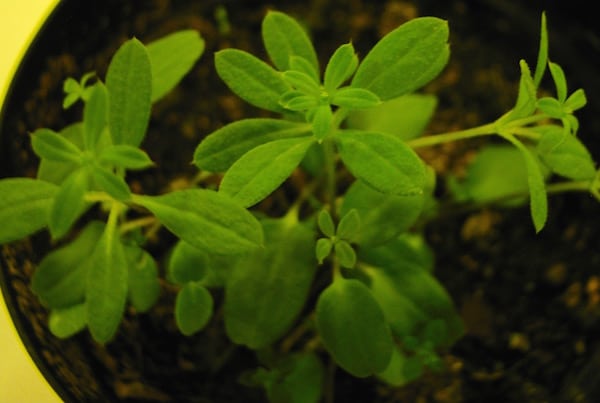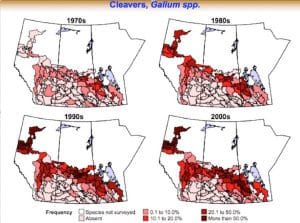Cleavers can be a persistent challenge for canola growers. They have been a difficult weed to manage for a number of reasons, including herbicide resistance (Group 2), climate changes and moisture conditions interfering with the timing of herbicide applications.

A well-managed, systematic approach is the best strategy for bringing cleavers under control.
Fall and spring management
Cleavers can exhibit a winter or summer annual lifecycle. An application of glyphosate in the fall followed by a spring pre-seed burnoff can go a long way toward reducing populations.
Use higher glyphosate rates. When applying glyphosate to manage cleavers, the half-litre rate (180 g/ae) is likely not enough. One to 1.5 litres (360-540 g/ae) per acre will control these weeds more effectively. Higher rates are also less inclined to select for metabolic mechanisms of resistance that accumulate more quickly with lower application rates of glyphosate.
Tank mix. Glyphosate should be mixed with other modes of action (from Group 2, 4, 6 or 14) where possible to improve control and reduce the risk of resistance. Fall or spring applications of ethalflurin (Edge) can also be used to suppress cleavers.
Clomazone (e.g. Command) is a group 13 soil applied herbicide, which will provide early residual control of cleavers. It can be applied pre-seed with a glyphosate burn-off application and works with all herbicide tolerant canola. Clomazone reduces the initial flush of cleavers, reducing the pressure on in-crop herbicides which improve control of cleavers. Clomazone is registered for pre-plant application in canola and leaves no detectable residue on seed, oil or meal.
Integrated management practices
Higher seeding rates are one way to increase crop competition.
In-crop management in canola
Aim for early application. Both glyphosate and glufosinate work best on smaller spring germinating plants. Early herbicide application is also best for crop yield. Use a rate and water volume suitable for cleavers.
Use crop rotation to your advantage
Prioritize cleavers control in cereals. As you plan your cleaver control program, remember that a wider range of pesticide options are available to you during the cereal year of your rotation. Prioritizing cleavers control in cereals will lower seed return to the seed bank and will have a carryover effect, which helps keep subsequent canola crops clean.
The range of cleaver control options in cereals is quite robust, with a wide selection of pre-plant (glyphosate, tribenuron, metsulfuron, safluenacil, florasulam) and in-crop herbicides (fluroxypyr, florasulam, dicamba, pyrasulfotole, pyrosulam, quinclorac, mecoprop-p) available. These herbicides give producers an assortment of herbicide groups (2, 4, 9, 14, 27) to choose from.
Group 4 herbicides, which are extensively used to control cleavers in cereal production, are known to be extremely low risk for developing herbicide resistance, making them a long-term tool in combating cleaver populations (Beckie, 2006). But remember that overuse of any herbicide group can lead to the evolution of resistance to that group.
IMPORTANT NOTES:
Quinclorac is not currently a recommended control option in canola due to trade uncertainties. Click here for more information.
Some cleavers are herbicide-resistant. Many cleavers populations are Group-2 resistant. And as long ago as 1998, a population of Group-2 resistant biotypes found in central Alberta was cross-resistant to quinclorac, an auxin-type Group 4 herbicide.
Keep it Clean: When planning any weed control program, always: 1) use acceptable pesticides that are registered for use on canola and won’t create trade concerns, and 2) follow the label for rates and timing. Use the Spray to Swath calculator and be sure to Keep it Clean.


